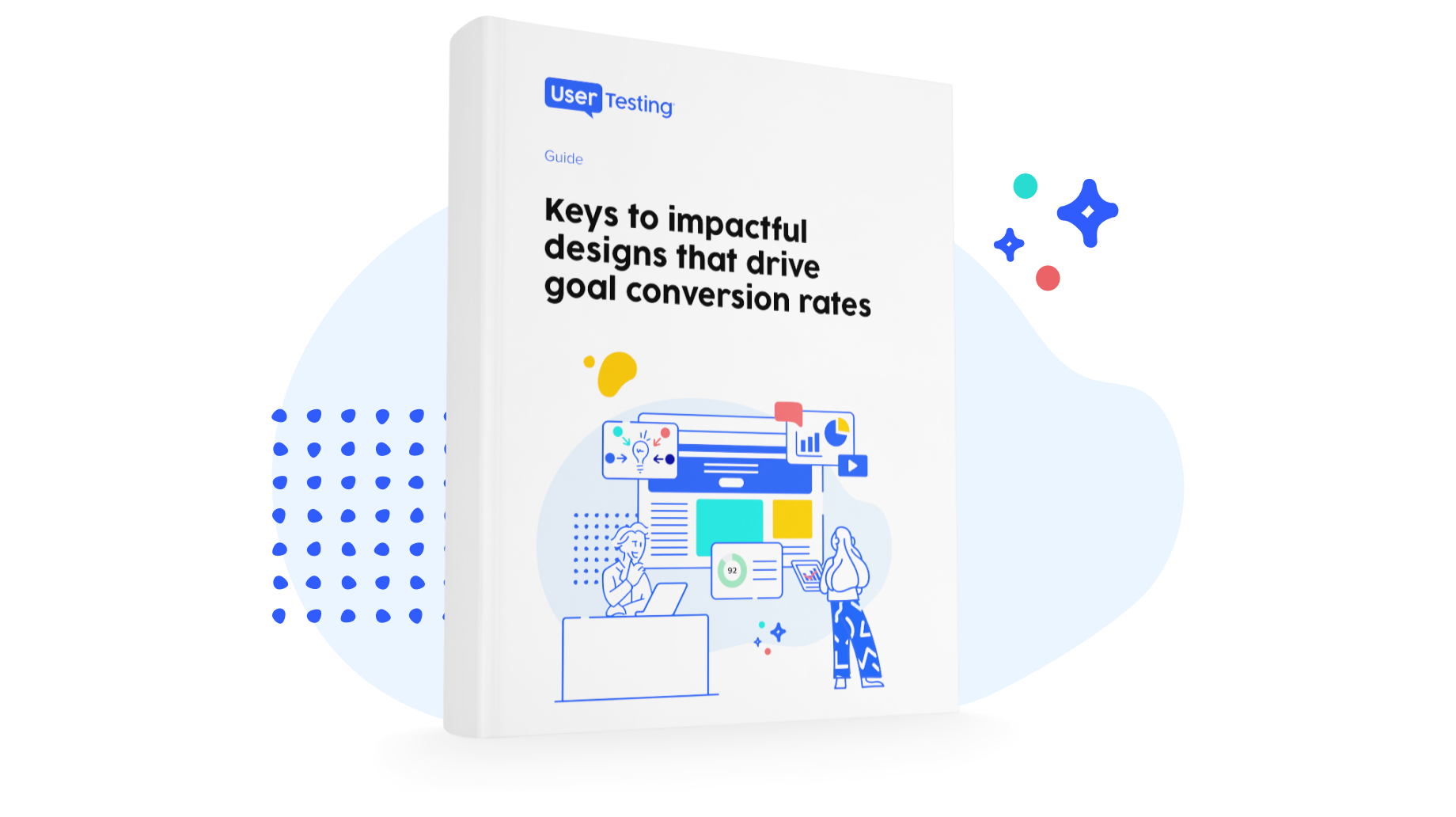
8 ways UserTesting can help UX design teams

Good UX design teams continually seek tools and approaches to better understand their customers and build human-centric, market-winning experiences. As technology and customer expectations advance rapidly, organizations have to be able to continuously make data-backed strategic decisions to remain competitive.
UserTesting makes it possible for teams to understand customer perspectives at all stages of the design process. Whether designers are brainstorming new products or perfecting existing solutions, UserTesting offers on-demand access to consumer feedback at every product milestone. With this solution, teams can greenlight ideas faster, measure experience impact, and optimize customer-facing touchpoints.
This article explores eight ways UX design teams typically leverage UserTesting to get better results. The use cases and case studies showcase how UserTesting helps organizations drive innovation, accelerate results, and differentiate their designs from the competition.
1. Leverage powerful integrations
For UX design teams, one of the quickest wins is to take advantage of UserTesting’s powerful integrations with their existing tech stacks. This allows designers to easily capture customer perspectives and embed learnings in commonly used tools across product development such as FigJam, Miro, InVision Freehand, Jira, and more.
Design teams using Figma, for instance, can simply add their Figma link to a UserTesting study to import their prototype. Live updates to the designs sync via the shared link, saving teams the need to reconfigure tests. Testing is secured with built-in compatibility for managing security on Figma links and the ability to have contributors sign the company’s NDA via UserTesting.
Design teams can then leverage actionable insights from Figma prototype tests with UserTesting’s AI-powered post-test analysis, metrics summaries and visualizations of user flow. Those insights and feedback videos can be easily embedded into the tools your stakeholders work within such as FigJam or Jira. It’s all a designer-friendly, template-guided experience that makes it easy for UX design teams to validate designs, find the right audiences quickly, and summarize insights.
Online streaming company, Deezer, tested Figma mobile prototypes extensively with UserTesting to great results. They recruited, moderated, recorded, and analyzed insights from contributors in the US, Mexico, Brazil, the UK, France, and Germany. After setting up a prototype test in UserTesting, product designers made live updates to their prototypes in response to early insights, without having to modify the original test configuration, allowing quick and iterative testing.
2. Visualize a customer’s journey
Design teams need a detailed understanding of the customer journey. To properly identify opportunities to optimize a solution’s experience, designers should map out the actions customers take—across multiple touchpoints—and take note of any friction points they may encounter. A visual mapping of the customer journey helps teams uncover potential improvements across digital channels and assess which customer needs have the potential to impact product design decisions.
UserTesting delivers an effective method for design teams to analyze the end-to-end journey a customer goes through when engaging with their product. By setting up customized user tests, UX teams can gain visibility into every step the customer takes, as well as emotional feedback on barriers they experience along the way. For example, where does the journey first break down? What causes user drop-off at later stages? Feedback can be layered over touchpoints to highlight usability issues, confusing interfaces, or missing information that frustrates customers.
With such journey insights from their target audience's lens, UX design teams can pinpoint systemic issues as well as quick wins to smooth the path to conversion. Enhancements may include simplified interfaces or entirely new features that help improve the customer experience. Continuously gathering customer journey insights via UserTesting assists brands in improving experiential metrics like satisfaction, engagement, and loyalty over time.
For example, the non-profit organization World Education Services (WES) works to connect international students and professionals with education and employment prospects in the U.S. and Canada. In their quest to improve digital customer journey, increase satisfaction, and eliminate challenges, WES turned to UserTesting. UserTesting's highlight reel, or HLR feature, helped WES communicate key findings to shareholders and efficiently implement design modifications to streamline their overall customer experience.
3. Discover user needs and frustrations
Uncovering unmet needs or frustrations with current experiences allows UX teams to identify the biggest opportunities for new features or entirely new product offerings. However, speculating on customer pain points carries risk. UserTesting enables direct discovery of needs and barriers by putting target users behind the lens.
Participants can share candid thoughts while attempting realistic tasks and engaging with a product or a process. Design teams gain an unfiltered view into exactly where and why existing solutions fall short. Observing user behavior and emotion firsthand makes clear if the experience confuses, annoys, or disappoints them. Feedback might spotlight confusing workflows, missing information, counterintuitive navigation, or lagging capability as pain points. This concrete data can validate known assumptions around pain points or reveal unexpected areas for innovation.
Equipped with evidence of customer struggles, design teams can confidently build roadmaps to alleviate the top frustrations through better design or additional functionality. Continuously gathering qualitative insights via UserTesting also allows organizations to stay ahead of evolving user needs over time.
Amazon Seller Central leverages UserTesting to actively involve both existing and potential Amazon sellers, gaining insights into their needs and challenges within the current settings. With this knowledge, they were able to improve navigation and ensure that all of their use cases were being covered.
4. Better understand a customer's environment
Gaining visibility into how customers engage with products in their native environments provides another invaluable context for UX design teams. By observing real-world customer behaviors, habits, and workflows related to an experience, teams are able to identify improvement areas that traditional research may miss. UserTesting offers an effective approach for gathering ethnographic-style insights right from a target user's home or workplace.
Design teams can use UserTesting to prompt participants to complete realistic tasks and capture their surroundings on camera. This gives designers the ability to literally view the environment in which customers operate. It helps answer vital questions about whether products seamlessly fit user lifestyles and work ecosystems or whether friction exists. Do users need to adapt behaviors to incorporate products into existing flows? Is specialty equipment or setup required on the user end? By assessing usage patterns in authentic customer contexts, teams can unearth issues and opportunities to optimize adoption and satisfaction.
5. Prioritize a product feature
Design teams face an ongoing challenge in determining which product features should take top priority. With limited resources and packed roadmaps, building new functionality or enhancing existing features demands evidence-based decisions about what matters to users. UserTesting enables teams to identify which capabilities will impact customer experience most.
By setting up optimized tests, UX teams can gain data-driven insights into how users rank potential improvements and new features based on several criteria. For example, they may ask participants to score items on dimensions like usefulness, usability, or novelty. This reveals exactly where target users feel teams should be focusing their efforts first. The quantitative data and qualitative feedback help designers understand which features users find indispensable versus just "nice to have."
With clear validation of what users value most, designers and product managers can then confidently determine project sequencing and resource allocation. Continuously gathering these user insights via UserTesting allows organizations to ensure their roadmap concentrates on delivering the capabilities that users care about before exploring more discretionary enhancements.
IBM employs UserTesting to identify features that boost user satisfaction and which factors encourage purchases and adoption. They conduct more than 3,000 sessions annually to gather these valuable insights.
6. Validate a design concept
Testing concepts with real users early in the design process helps teams validate ideas before sinking costs into prototype or full product development. Rather than speculating how target customers might respond to changes, UserTesting gives designers an efficient way to put novel concepts in front of participants and gain candid perspectives. By presenting proposed interfaces, flows, interactions, or content and having users think aloud as they review, teams can rapidly gather feedback to assess market viability.
This approach helps them determine which concepts engage user interest versus falling flat so they can double down on truly compelling ideas. Since participants share their raw, unfiltered thoughts as they consume concepts, designers hear explicit language around what resonates or conflicts so they can hone elements accordingly. By kickstarting real user co-creation early on, teams can feel empowered to invest in concepts users grasp and get excited by. They can also ensure they don't miss unmet needs that could inform better design directions.
7. Evaluate a prototype
After a design team has moved on from the conceptual stage, they’re ready to develop a prototype. Getting design prototypes in front of target users early on ensures teams build what customers actually need rather than wasting effort. UserTesting enables teams to validate proposed designs rapidly with the true end-user perspective. By showing participants usable prototypes and having them complete realistic tasks and feedback, teams can identify usability issues and friction points while designs are still in the initial development phase.
Observing real people interact with prototypes uncovers if the navigation, interfaces, flows, or features align with user expectations at that stage. Teams gain actionable insight around potentially confusing elements to refine or functionality that users want differently. Rather than waiting months to learn prototypes missed the mark, UserTesting offers an agile way to fail fast and redirect design efforts while changes remain relatively easy. It allows teams to deliver the experience and value customers care about most in the final product.
For instance, Panera leveraged UserTesting by rapidly testing prototypes to gauge users' reactions to their catering website redesign. This helped them uncover and fix points of friction within their setup and checkout processes.
8. Evaluate the competition
Understanding how one's offering stacks up against competitors should be an ongoing priority for design teams. UserTesting provides invaluable insight into the customer perspective on a brand's solution versus rival solutions so organizations know precisely where they must match or exceed the capabilities users value most. Comparing feature functionality, usability, and emotional dimensions like trust and affinity allows teams to pinpoint differentiating strengths and feature gaps.
Teams gain unbiased data around preferences by showing participants comparable flows or interfaces from key competitors and having them complete tasks and provide feedback. They can objectively evaluate if new features introduced elsewhere excite customers or offer an opportunity to deliver better execution and experience. Competitive insights may inform enhancing existing capabilities, revising messaging or positioning, or fueling new functionality to address unmet user needs competitors overlook.
For instance, when initial customer testing showed their new online booking experience was not favorably differentiated, Costco Travel turned to UserTesting for competitor analysis. Comparative feedback revealed their confusing website navigation menu needed enhancement. By addressing these quickly, Costco Travel launched its new product offering, leading to higher customer-curated travel bookings and fewer service calls.
Convert insights to customer-centric products and services with UserTesting
As these use cases demonstrate, embracing UserTesting as a core function of a design team unlocks immense value in building truly customer-centric experiences. By continually gathering insights from target users, design teams can mitigate risk, validate strategic directions, and align every product iteration with user needs.
Whether the aim is to pinpoint friction in an online shopping experience, compare prototype concepts, test advertisements, or benchmark capabilities against competitors, UserTesting offers on-demand access to user perspectives. It allows teams to course-correct with agility when ideas miss the mark and double down on what delights people.
In today's market, creating differentiated, delightful customer experiences is the top necessity for any product or service. UserTesting delivers the evidence teams require to deliver the right solutions quickly and efficiently.
Convert user insights to design customer-centric products and services that exceed expectations.

Create designs that drive goal conversions
Learn how to strategically optimize goal conversion rates by predicting the impact of design choices—before development begins.





